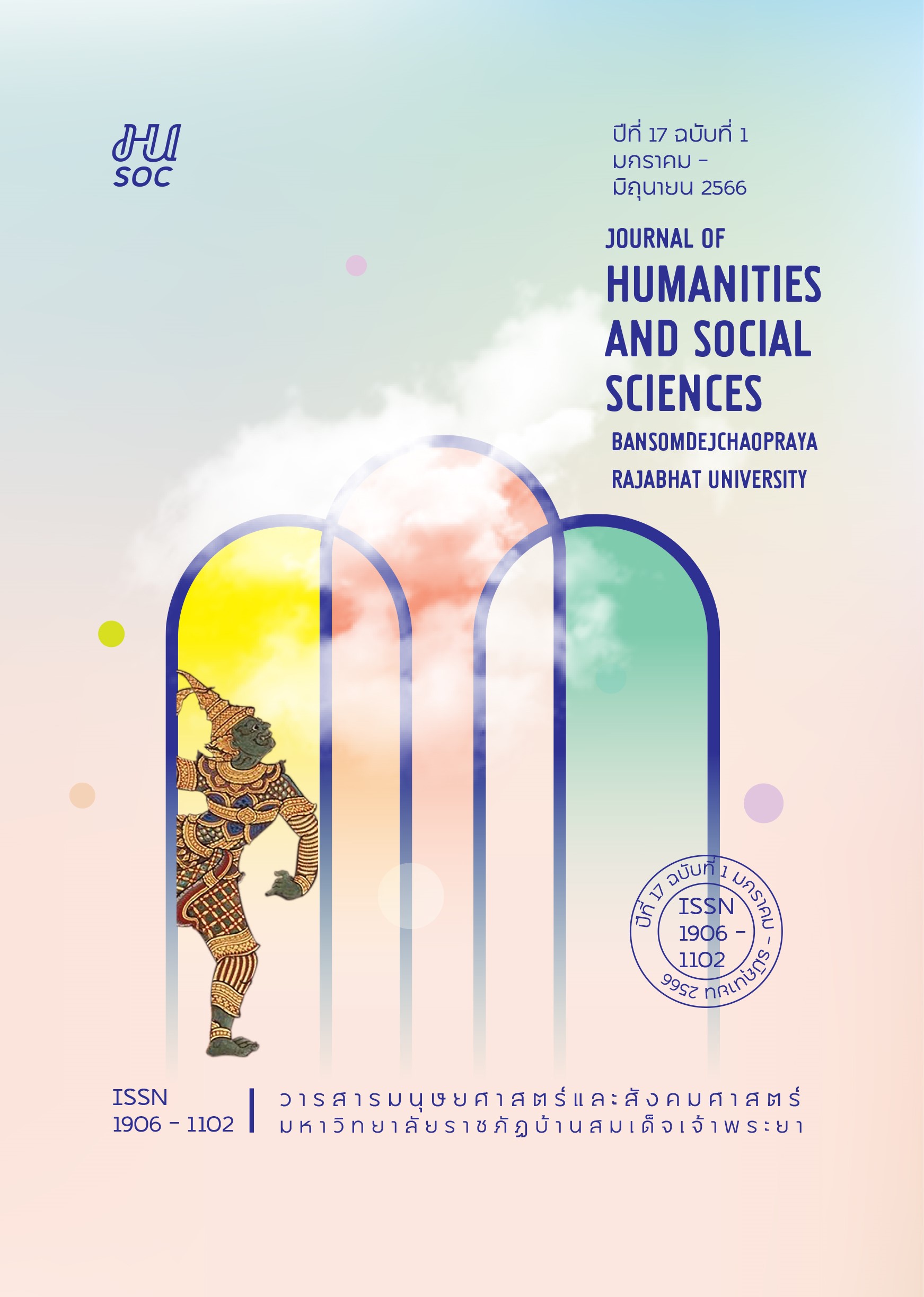The Myth of Mien Origin, Symbology in Textile: An Archive of Iu Mien Embroidery Motifs from Ban Pang Kha, Pong District, Phayao Province
คำสำคัญ:
Iu Mien embroidery, Iu Mien textile, Material folklore, Myth of textileบทคัดย่อ
This research focused on the study of Iu Mien embroidery motifs. Iu Mien is a Thai ethnic group, which generally lives in the hill area. Their dress and costume have a strong, unique ethnic identity. Iu Mien’s knowledge and skills in textiles are usually hands-on by a matriline. Iu Mien embroidery is across-stitch technique, and the appearance is in a geometric pattern based on the fabric grid lines. The distinctive feature of ethnic embroidery is that the design is stitched directly onto the fabric’s reverse without leaving any knots, so it is beautiful
on both the front side and back side. Moreover, the pattern is connected to myths, beliefs, and ways of their life. The study site was in Ban Pang Kha, Pong District, Phayao Province, Thailand. The objective was to collect data and evidence of traditional embroidery motifs in text and photographs for an archive and as a document for future generations. The research approach and methods were studied using evidence from old fabric and personal interviews. The analysis was based on the theory of material folklore by studying the myth of the Iu Mien’s origin, a deity named Pan Ku, a dragon dog, and a scripture painting called Cia Sen Pong - a passport of the Iu Mien tribe. The results showed approximately 60 traditional embroidery motifs of the Ban Pha Chang Noi, Ban Pang Kha, and Phu Lanka Districts. Some of the motifs were linked to the myth of the Iu Mien’s origin. Other patterns were inspired by the environment, nature, and life.
เอกสารอ้างอิง
Anantasant, S. (2000). Watthuthāngwatthanatham [Material Culture]. In thritsadī khati chon læ withīkān sưksā [Folklore Theoryand techniques]. (pp. 206-207). Ramkhamhaeng University Press. http://old-book.ru.ac.th/e-book/t/TS650/ts650-11.pdf
Department of Empowerment of Persons with Disabilities. (2000). phā chāo khao [Hill Tribe textile]. Ram Thai Press.
Holliday, D. R. (1996). Folklore: What is it? IX. Retrieved 14 June 2022, from https://thelibrary.org/lochist/periodicals/ozarkswatch/ow904b.htm
Innovation Research and Development Department. (2020). chāo Thai phūkhao phao mīan (yao) læ kānsāng san phā pakmīan [ Mien and their creative embroidery]. Retrieved 9 June 2022, from https://www.sacit.or.th/uploads/items/attachments/ca889fd9b844559dc1d47b4a52d5e40b/_3482b592439d43ddb875dbbbc75f5fe3.pdf
Museum Thailand. (2019). tamnān phā pak chāo mīan [The Myth of Mien Embroidery]. https://www.museumthailand.com/th/1728/storytelling/ตำนานผ้าปักชาวเมี่ยน/
Nakrob, S. (2008). The Five Ancient Yao Embroidery Designs. Humanity Journal, 15(2), 56-66. https://so04.tci-thaijo.org/index.php/abc/article/view/52503/43545
Lueraj, P. (Photographer). (2022). Traditional costumes and dress of the Mien from Ban Pang Kha. [image]. Ban Pang Kha: Phayao.
Lueraj, P. (Photographer). (2022). The basic stitch and stem stitch. [image]. School of Architecture and Fine Arts: University of Phayao.
Lueraj, P. (Photographer). (2022). The basic stitch and chain stitch. [image]. School of Architecture and Fine Arts: University of Phayao.
Lueraj, P. (Photographer). (2022). Illustration of the basic stitch. [image]. School of Architecture and Fine Arts: University of Phayao.
Lueraj, P. (Photographer). (2022). Basic straight stitch. [image]. School of Architecture and Fine Arts: University of Phayao.
Lueraj, P. (Photographer). (2022). Illustration of a straight stitch. [image]. School of Architecture and Fine Arts: University of Phayao.
Lueraj, P. (Photographer). (2022). The Thio technique. [image]. School of Architecture and Fine Arts: University of Phayao.
Lueraj, P. (Photographer). (2022). Illustration of the Thio technique. [image]. School of Architecture and Fine Arts: University of Phayao.
Lueraj, P. (Photographer). (2022). Basic cross stitch. [image]. School of Architecture and Fine Arts: University of Phayao.
Lueraj, P. (Photographer). (2022). Illustration of the Dap Yat technique. [image]. School of Architecture and Fine Arts: University of Phayao.
Lueraj, P. (Photographer). (2022). The Mien embroidery motifs, which were collected for analysis. [image]. School of Architecture and Fine Arts: University of Phayao.
Lueraj, P. (Photographer). (2022). Zom motif represents the soldier. [image]. School of Architecture and Fine Arts: University of Phayao.
Pourret, J. G. (2002). The Yao The Mien and Mun Yao in China, Vietnam, Laos and Thailand. Amarin Printing and Publishing.
Srisombat, F. (2021). tamnān phā pak mīan. [The Myth of Mien Embroidery] [Interview].
SrisomBhat, K. (2021, 19 December 2021). History of Mien in Ban Pang Kha. [Interview].
Srisombat, R. (2018). The role of Mien Lady Shaman in patriarchal society. Social Science Journal, 30(1), 31-63.
Thongkum, T. L. (1991). phrarātchasān phračhaophing wāng chai pō̜ngkan tūa samrap kāndœ̄nthāng khām phūkhao chabap thāwō̜n. [Gao Shan Bang Perpetual Redaction of Imperial Decree of Emperor Ping Huang for Protection When Travelling in The Hills]. C. U. Linguistic Research Unit Faculty of Arts.
Wannamas, S. (2009). mǣlāi phā pak mīan (yao) nai čhangwat Chīang Rāi læ Phayao. [Mien Embroidery Motifs in ChiangRai and Phayao]. J. H. T. Foundation.
Woodward, S. (2013). Material Culture. Oxford Bibliographies. Retrieved 14 December 2022, from https://www.oxfordbibliographies.com/display/document/obo-9780199766567/obo-9780199766567-0085.xml
ดาวน์โหลด
เผยแพร่แล้ว
รูปแบบการอ้างอิง
ฉบับ
ประเภทบทความ
สัญญาอนุญาต

อนุญาตภายใต้เงื่อนไข Creative Commons Attribution-NonCommercial-NoDerivatives 4.0 International License.




